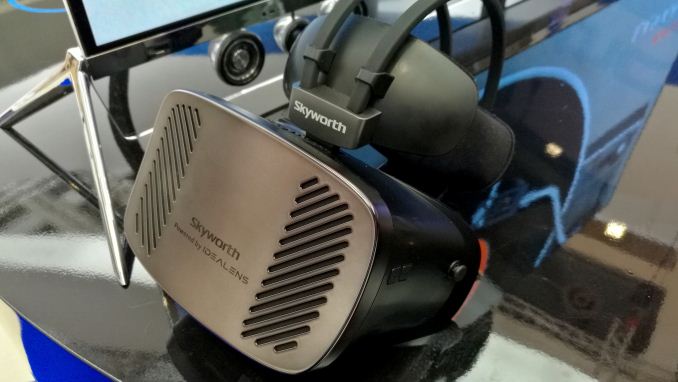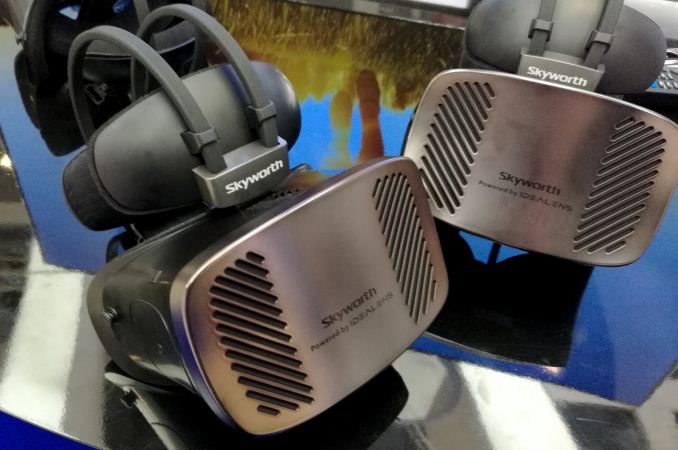IFA 2016: Examining the Malaise of Bargain Basement Virtual Reality
by Dr. Ian Cutress on September 9, 2016 9:00 AM ESTGoing Above $100: The Skyworth AIO-VR
In the last few minutes of the show I was steered towards the Skyworth booth in a different hall and told to go see their all-in-one headset. I was told that in comparison to the others, the Skyworth offering might be a substantial substitute above the cheap VR on display. The problem is always the cost, which we’ll get onto in a minute. The Skyworth VR setup was on display to test, however there were no specifications on display, and we weren’t allowed to take a picture of the image on the demonstrator’s phone that had all the hardware listed, but I was able to memorize a few key points.
It’s worth saying that the Skyworth AIO-VR was slightly bulkier than the other headsets, if only because the mechanism to mount it on your head was a plastic part of the design, aimed at balancing the weight a little but also securing it more firmly with padded guards. The outside was still plastic, however with a brushed metal look, and slightly more attention to detail.
The units were up and powered, and after putting it on I could tell the interface was smooth. Don’t get me wrong, the pixels were still quite obvious, but moving my head showed a high frame rate display better than the 30/60 Hz offerings of the cheaper implementations.
As far as I could jot down in a reasonable time, the headset uses an Exynos 7420, which is a 4x4 big.Little design using quad ARM Cortex A57 at 2.1 GHz and quad ARM Cortex A53 cores at 1.5 GHz on a 14nm process. The 7420 also uses Mali-T760MP8 graphics, at 772 MHz, which is good for 210 GFLOPs, and is paired with dual-channel (2x32-bit) LPDDR4. This SoC was powering dual 1080x1200 displays inside, which is a formidable number of pixels, and I saw that we’re looking at a 3800 mAh battery. Other specifications I can’t remember, though one would assume a 4GB/64GB arrangement for memory and storage if this was a smartphone.
So here’s the thing: the Skyworth headset is essentially a smartphone under the hood that you can’t take out. So what makes it better than a Samsung VR headset where the smartphone can be attached / detatched? One would assume it’s a price thing, and we were told the price for the headset could be $400 to $800. I remarked that it was a pretty large range, but was told that the Skyworth headset is still a work in progress, with exact specifications to be decided later. If it was $400, it might be more palatable, but for $800 then it might be easier to go the smartphone route.
The Problem with Low Cost VR
This brings us around to the problem with VR right now. Everyone wants in on the bandwagon, and in a keynote at the event it was pointed out that in order for triple-A style games and film studios to start making content in these new formats, there needs to be more potential sales out there. Current estimates put 500k headsets in the market (of varying degrees of power) with another 2.7 million by the end of 2017. No game studio or film studio, working on the next FPS or Avatar, will make a massive piece of content for only 3.2 million people – it needs to be in the hands of tens of millions to even start to make sense, and we won’t be at that point for a number of years.
All that being said, you have a choice – investing in a premium VR headset to be able to experience the best will cost $700+, in terms of the headset itself plus any extra hardware you need to power it. The easiest way to enter the VR space with some clout is the smartphone or all-in-one route, but that is still a hefty cost. Then there is a large, long gap to the segment of very basic all-in-one virtual reality headsets as shown at IFA this year.
For $100, or the rough price of the Samsung headset without any internal hardware, you get a basic quad-core Rockchip design with limited functionality. I’m half inclined to suggest that a bucket be provided as well, just in case nausea takes over. But it shows what a state VR is in, when the hardware is still so expensive. In order to get a base experience that can truly be called VR, such as with the Skyworth headset, it might be as much as a high-end smartphone anyway. For mass market adoption, the cost to enter has to be low, but not so low we’re scraping the barrel for basic frame rates.
Picture Galleries















































59 Comments
View All Comments
nathanddrews - Friday, September 9, 2016 - link
So if I had to summarize this article:At its best, VR is really expensive (headset/controller equipment + hardware to run it well) and mostly limited to rail-based shooter games, racing games, and flight sims... and anything less than that is basically not worth doing.
I've always love the idea of VR, but it's still too niche for me to invest in right now.
BugblatterIII - Friday, September 9, 2016 - link
That's not even close to the types of games and experiences that dominate the available content.VR's still finding its feet in terms of what genres port well and what new genres could be created, but the ones you've listed are perhaps the least suited to VR because they're mostly very nausea-inducing.
I agree that it's worth going the whole hog though. I had the Gear VR for years and now have the Vive, which is so far above the Gear it's a different species.
Mr Perfect - Friday, September 9, 2016 - link
It's the on-rails bit that kills it for me. Why can't they just have a thumstick on one of the hand held controllers to handle X Y movement? It's otherwise quite fun.prisonerX - Friday, September 9, 2016 - link
Because people don't want to throw up.theduckofdeath - Monday, September 12, 2016 - link
Yeah ,you need the movement sensors in the HMD or you shouldn't have any. Unless you have flawless hand to eye coordination that is, then a joystick can replace that. But, that person does not exist, I think. :Dmkozakewich - Monday, September 12, 2016 - link
From my experience playing Minecraft on the Rift DK1, it's not really the character movement that causes motion sickness. For me, it was the jittering when I turned my head. I eventually adapted to keeping my head still and using only the mouse to "turn" my head. The abstraction worked for me, because I'm used to playing video games, but I suppose one of the main draws of VR is in having that kind of control.So movement is possible, but you do need high frame-rates if you want to let players look around with their head without causing nausea.
sonicmerlin - Thursday, September 15, 2016 - link
You really think your experience applies when you've only tried the very first prototype?Flunk - Friday, September 9, 2016 - link
I suspect these headsets aren't designed for the US market, but rather the Chinese market, where the vast majority of customers couldn't possibly afford a Rift or Vive and the $2000 PC to power it.xype - Friday, September 9, 2016 - link
To be fair, I don’t know many people (I’m living western Europe) who can afford a Rift or Vive and the $2000 PC to power it, either. Or, those I do know, aren’t interested in the least—even though they would all classify as geeks. Sure, they’ll try it out at a show/convention, exclaiming "Neat!", but once the headset is off, "Not $3k neat, though…".sphigel - Friday, September 9, 2016 - link
If these "geeks" don't already own at least a good portion of the $2000 computer required for VR then they really aren't geeks are they? Most people interested in VR already have powerful gaming rigs. Yes, you might need a video card upgrade but that's about it. It's a bit disingenuous to say that VR costs $3k to get into.